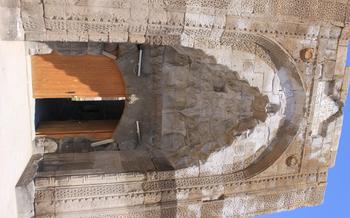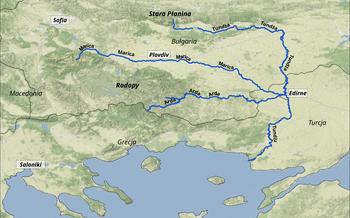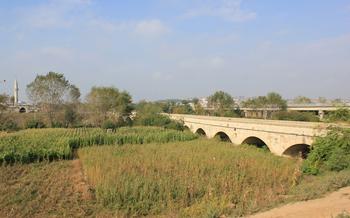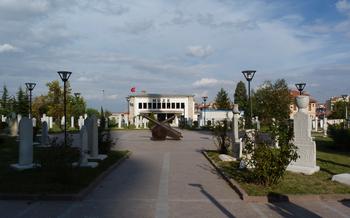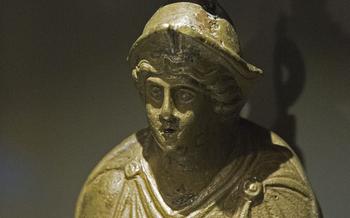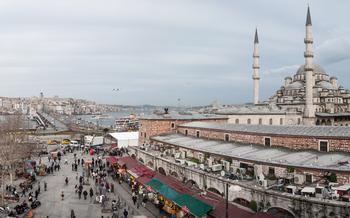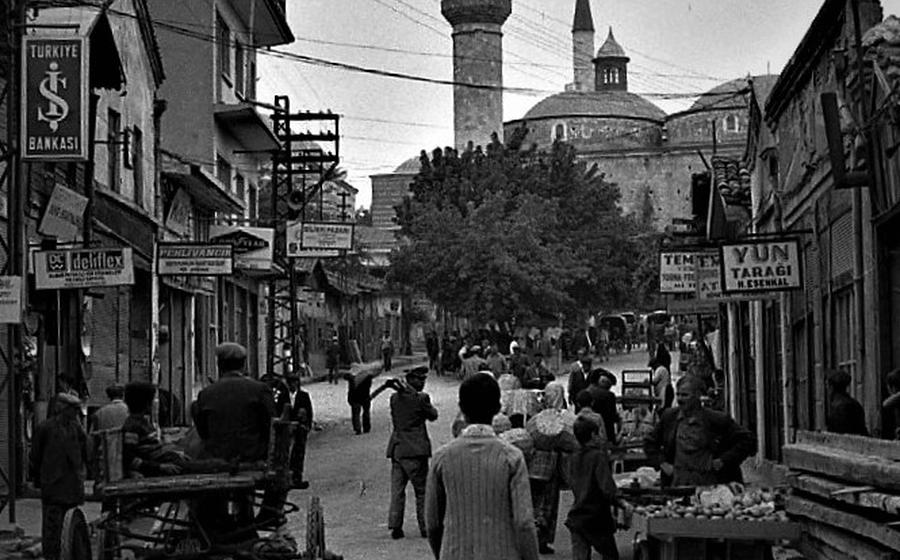
Ipsala Gate
- Historical Significance:
- Architectural Features:
- Visiting the Gate
- Things to See Nearby
- Historical Context
- Restoration and Preservation
- Insider Tips for Visitors
- Educational Programs
- Literary and Artistic Depictions
- Sustainable Tourism
- Future Development
- Local Cuisine
- Photography Tips
- Insider Tip: Uncover the Hidden Passage
Historical Significance:
The Ipsala Gate stands as a testament to the rich history and strategic importance of Edirne during the Ottoman era. Built in the 15th century, it served as a crucial gateway between the Ottoman Empire and Europe. Through this gate, countless travelers, merchants, and armies passed, leaving behind a tapestry of stories and encounters. The gate's architectural design, blending Ottoman and European influences, reflects the cultural crossroads it represented. Its intricate carvings, arches, and decorative motifs showcase the artistry and craftsmanship of the period. Explore the Ipsala Gate, and you'll discover a tangible link to the past, where history whispered secrets in every stone.
Architectural Features:
The Ipsala Gate stands as a testament to the architectural prowess of the Ottoman Empire. Its unique design blends Ottoman and European elements, creating a striking and awe-inspiring structure. The gate's facade is adorned with intricate stone carvings, arches, and decorative motifs that showcase the artistic skills of its creators.
The gate's thick walls, towers, and loopholes reveal its defensive capabilities. These features were designed to protect the city from invaders and served as a formidable barrier against enemy forces. The gate's strategic placement allowed for effective surveillance and control over the movement of people and goods along the Balkan route.
Comparing the Ipsala Gate to other Ottoman fortifications, one can observe similarities in architectural style and defensive elements. For example, the gate shares similarities with the Belgrade Gate in Belgrade, Serbia, and the Adrianople Gate in Edirne, Turkey, all of which exhibit a blend of Ottoman and European influences.
The Ipsala Gate stands as a magnificent example of Ottoman architecture, showcasing the empire's military prowess and artistic achievements. Its unique design and defensive features make it a fascinating subject for study and admiration.
Visiting the Gate
To visit the Ipsala Gate, make your way to the town of Ipsala, located approximately 20 kilometers from Edirne city center. The gate is situated at the western entrance of the town, easily accessible by car or public transportation. Parking is available nearby, allowing you to conveniently explore the gate and its surroundings.
The Ipsala Gate is open to the public throughout the day, offering free admission to all visitors. Whether you prefer a quiet morning stroll or a sunset visit, the gate welcomes you to immerse yourself in its historical charm. Guided tours are available upon request, providing a deeper Einblick into the gate's significance and architectural details.
To fully appreciate the gate's grandeur, plan your visit during the golden hours of sunrise or sunset. The warm hues of the setting sun cast a magical glow on the stone facade, creating a picturesque scene that will leave you in awe. Capture these moments with your camera, or simply soak in the beauty of this architectural masterpiece.
Things to See Nearby
Complement your visit to the Ipsala Gate with a journey through Edirne's rich cultural heritage. Within walking distance, discover the Edirne Museum, housing a collection of artifacts and exhibits that narrate the city's captivating history. Delve into the serene ambiance of the Selimiye Mosque, a masterpiece of Ottoman architecture renowned for its grandeur and intricate tilework. Explore the vibrant Edirne Bazaar, a bustling marketplace where you can haggle for traditional Turkish handicrafts, spices, and delicacies.
For a glimpse into Edirne's culinary scene, savor the flavors of Ciğerci Ali Usta, a local gem famous for its succulent grilled liver dishes. Indulge in the sweet delights of Şekerci Ali Usta, a confectionery shop renowned for its mouthwatering Turkish delight.
If time permits, embark on a day trip to the Uzunköprü Bridge, an architectural marvel spanning the Ergene River, or venture further to the Thracian University, where you can delve into the region's academic and cultural pursuits.
Whether you choose to explore Edirne's historical landmarks, immerse yourself in its culinary delights, or venture beyond the city limits, you'll find a wealth of experiences to enrich your visit.
Historical Context
The Ipsala Gate stands as a testament to the rich history and strategic significance of Edirne, a city that once served as the capital of the Ottoman Empire. During the empire's expansion, Edirne's location at the crossroads of Europe and Asia made it a pivotal center for trade and diplomacy. The Ipsala Gate played a crucial role in controlling the flow of goods and people along the Balkan route, connecting the Ottoman Empire with its vast territories in Europe.
The gate's strategic importance is evident in its impressive fortifications, including thick walls, sturdy towers, and strategically placed loopholes. These defensive features allowed the Ottoman Empire to protect its borders and maintain control over the region. Throughout its history, the Ipsala Gate witnessed the passage of armies, merchants, pilgrims, and diplomats, contributing to the cultural exchange and economic prosperity of the Ottoman Empire.
Beyond its military significance, the Ipsala Gate holds cultural and symbolic value. Its architectural style, blending Ottoman and European influences, reflects the empire's diverse cultural heritage. The gate's intricate stone carvings, arches, and decorative motifs showcase the artistic prowess and craftsmanship of the era. The Ipsala Gate stands as a symbol of the Ottoman Empire's power, resilience, and cultural legacy, reminding visitors of its enduring impact on the region.
Restoration and Preservation
The Ipsala Gate, a testament to Ottoman architectural prowess, has undergone extensive restoration and preservation efforts to maintain its grandeur. In the early 20th century, the gate faced significant deterioration due to neglect and the ravages of time. Recognizing its historical and cultural significance, authorities initiated a comprehensive restoration project in the 1980s. Skilled artisans and craftsmen meticulously repaired the gate's stonework, arches, and decorative elements, restoring them to their former glory.
The restoration process involved addressing structural issues, reinforcing the gate's foundations, and repairing damaged sections. The team also focused on preserving the gate's original features, ensuring that its historical integrity remained intact. They carefully cleaned and restored the intricate carvings and inscriptions, preserving the stories and symbols etched in stone.
Preserving a centuries-old structure like the Ipsala Gate comes with its challenges. The team had to balance the need for restoration with the preservation of its authenticity. They used traditional techniques and materials to ensure that the repairs blended seamlessly with the original fabric of the gate.
Today, the Ipsala Gate stands as a testament to the successful collaboration between restoration experts, historians, and local communities. It serves as a reminder of the importance of preserving cultural heritage for future generations, ensuring that this iconic landmark continues to captivate and inspire visitors for years to come.
Insider Tips for Visitors
-
Capture the Gate's Majesty: For stunning photos, position yourself directly in front of the gate to capture its full grandeur. Arrive early in the morning or late in the afternoon to avoid harsh shadows and take advantage of the warm, golden light.
-
Embrace Local Flavors: Indulge in a traditional Turkish breakfast at a nearby café. Savor the flavors of menemen (scrambled eggs with tomatoes and peppers) or simit (sesame-encrusted bread) with kaymak (clotted cream).
-
Discover Secret Spots: Explore the narrow, cobblestone streets surrounding the gate to uncover hidden gems like charming boutiques, antique shops, and art galleries.
-
Attend Local Events: If you're visiting during summer, don't miss the annual Edirne Selimiye Festival, which showcases traditional Turkish music, dance, and art.
Educational Programs
The Ipsala Gate is not just a historical monument; it is also an educational resource. The gate serves as a living classroom, where visitors can learn about history, architecture, and culture. Guided tours are available for groups, providing in-depth insights into the gate's history, architectural features, and significance. School groups often visit the gate as part of their history and social studies curriculum. Workshops and educational programs are also organized to engage students with the gate's rich heritage. Through these initiatives, the Ipsala Gate becomes a tangible link between the past and the present, inspiring future generations to appreciate and protect their cultural heritage.
Literary and Artistic Depictions
The Ipsala Gate has captured the imagination of writers, artists, and filmmakers throughout history. In literature, the gate features prominently in the works of renowned Turkish authors such as Ahmet Hamdi Tanpınar and Orhan Pamuk. Tanpınar's novel "Huzur" (Peace) vividly describes the gate's imposing presence and its role as a symbol of transition between East and West. Pamuk's "The Museum of Innocence" also references the gate as a backdrop for the novel's tragic love story.
In art, the gate has been immortalized in paintings, sketches, and sculptures by local and international artists. One notable work is a series of paintings by Edirne-born artist Fikret Mualla, who depicted the gate in various seasons and moods. His paintings capture the gate's architectural grandeur and its changing relationship with the surrounding landscape.
The gate's cinematic presence includes its appearance in several Turkish films and documentaries. One notable example is the film "Edirne Kapısı" (The Gate of Edirne), which tells the story of a young woman's struggle to preserve the gate's heritage amidst the challenges of modernization.
These artistic depictions reflect the gate's profound impact on the cultural landscape of Edirne and its enduring significance as a symbol of history, transition, and cultural exchange.
Sustainable Tourism
When exploring the Ipsala Gate and its surroundings, it is essential to practice sustainable tourism. This means respecting the site, avoiding littering, and supporting local businesses. By doing so, you can help preserve the gate's historical integrity and contribute to the local economy.
Sustainable tourism also involves minimizing your environmental footprint. Consider walking or cycling to the gate instead of driving. If you must drive, park in designated areas and avoid blocking traffic. Additionally, be mindful of your water and energy consumption, and reduce your waste by bringing reusable containers and shopping bags.
By embracing sustainable practices, you can help protect the Ipsala Gate and its surroundings for future generations to enjoy. Encourage others to do the same, and together, we can create a positive impact on the local community and environment.
Future Development
The Ipsala Gate stands as a testament to the rich history and cultural heritage of Edirne. As we look towards the future, there is great potential for further development and enhancement of the gate and its surrounding area. Plans are underway for careful restoration and preservation efforts to ensure that this iconic landmark continues to stand for generations to come.
Additionally, there are exciting possibilities for integrating the gate into modern urban planning and development. The area around the gate could be transformed into a vibrant cultural hub, with restored historical buildings housing museums, art galleries, and traditional shops. This would not only preserve the gate's historical significance but also create a dynamic space for locals and tourists alike to gather, learn, and experience the unique charm of Edirne.
The future of the Ipsala Gate is bright, and it is poised to play an even greater role in the cultural and economic landscape of Edirne. With careful planning and development, this architectural gem can continue to inspire and captivate visitors for years to come, while also contributing to the sustainable growth and prosperity of the city.
Local Cuisine
Edirne's cuisine is a delightful blend of Turkish and Balkan flavors, offering a rich culinary experience to visitors. While exploring the Ipsala Gate, take the opportunity to savor some of the local specialties. Traditional restaurants and cafes in the vicinity offer a range of dishes that showcase the region's unique culinary heritage.
One must-try dish is "Trakya Köftesi," a type of grilled meatball made with a blend of ground beef and lamb. These meatballs are often served with a tangy tomato sauce and are a popular choice among locals.
For a taste of traditional Turkish cuisine, try the "Edirne Tava," a hearty dish made with lamb or beef cooked in a clay pot with vegetables and spices. The result is a flavorful and aromatic stew that is sure to satisfy your taste buds.
Vegetarians can indulge in "Kıymalı Börülce," a delicious dish made with fresh green beans, minced meat, and aromatic spices. This dish is a testament to the region's love for vegetables and is often served as a side dish or main course.
No visit to Edirne is complete without trying the famous "Edirne Peyniri," a type of white cheese known for its rich flavor and creamy texture. This cheese is often used in local dishes and can also be enjoyed on its own as a snack or appetizer.
As you savor these culinary delights, take the time to appreciate the unique atmosphere of Edirne's local restaurants. Many of these establishments have been operating for generations and offer a glimpse into the city's rich history and culture.
Photography Tips
To capture the grandeur of the Ipsala Gate and create lasting memories, consider these photography tips:
-
Golden Hour Magic: Plan your visit during the golden hours, just after sunrise or before sunset, when the warm, diffused light casts a magical glow on the gate's stonework.
-
Angles and Perspectives: Experiment with different angles and perspectives to add depth and interest to your shots. Capture the gate's imposing facade from a low angle to emphasize its size, or shoot from a higher vantage point to include the surrounding landscape.
-
Composition and Symmetry: Take advantage of the gate's symmetrical design to create balanced and visually appealing compositions. Position the gate in the center of your frame and use leading lines, such as the road or pathways, to draw the viewer's eye towards it.
-
Tripod and Filters: For sharp and steady shots, especially in low-light conditions, use a sturdy tripod. Consider bringing neutral density (ND) filters to control the amount of light entering your lens, allowing you to capture long exposure shots with smooth water effects.
-
Hidden Details: Look for intricate details and carvings on the gate's exterior. Zoom in to capture the intricate stonework, decorative motifs, or inscriptions that tell stories of the past.
-
Unique Perspectives: Explore the area around the gate for unique vantage points. Capture the gate framed by trees, reflected in a nearby body of water, or dwarfed by the surrounding cityscape.
Insider Tip: Uncover the Hidden Passage
Beyond the imposing facade of the Ipsala Gate lies a hidden gem known only to a few locals. Tucked away in the gate's massive stone walls is a secret passage that once served as a strategic escape route in times of danger. Although now closed off to the public for safety reasons, the existence of this passage adds an air of mystery and intrigue to the gate's history. Imagine the stories it could tell of clandestine missions and daring escapes under the cover of darkness. As you stand before the Ipsala Gate, let your imagination wander and ponder the secrets it holds within.

